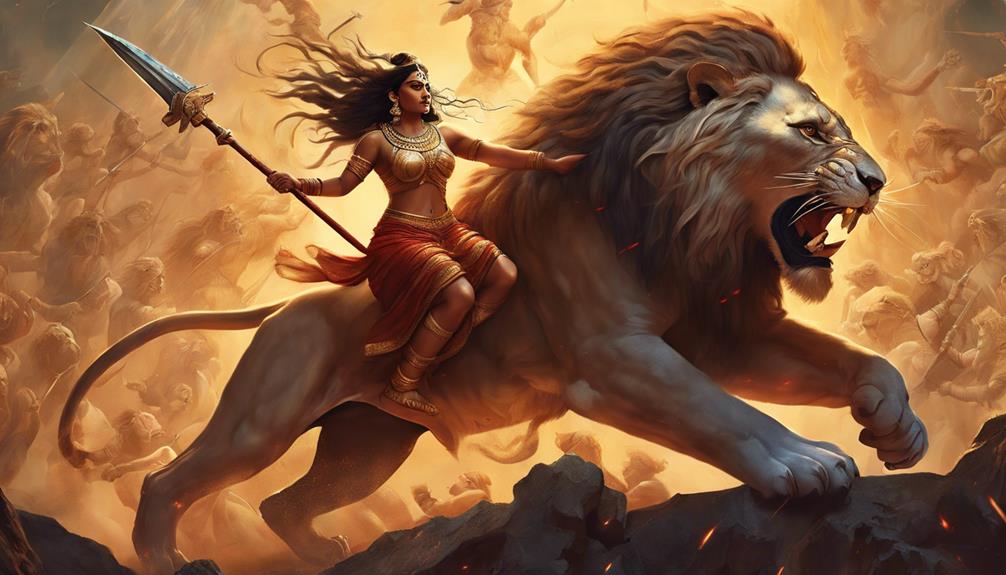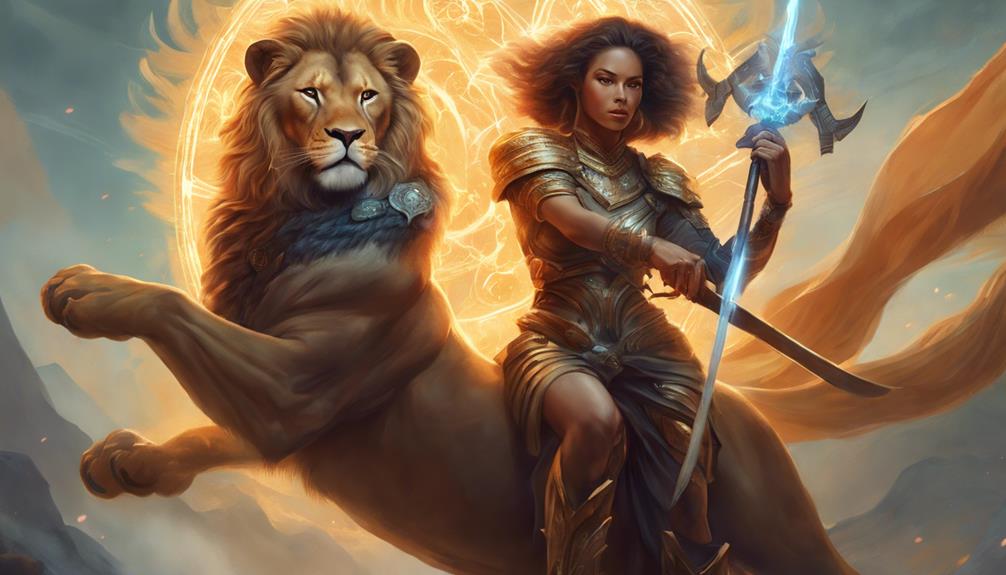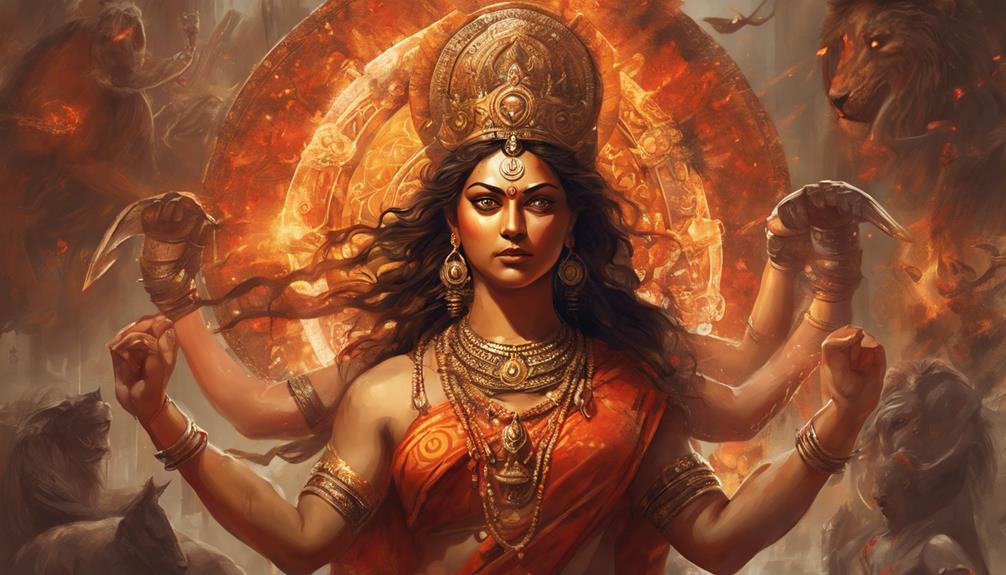Goddess Durga, known as Devi or Shakti, stands as a powerful and benevolent presence in Hinduism, revered for her embodiment of strength and protection. Her depiction as a warrior goddess in Vedic texts symbolizes the eternal battle against chaos and injustice, with her iconography showcasing multiple arms holding weapons, a trident, and riding a lion, all representing her might and grace amidst adversity.
Durga serves as a beacon of righteousness and dharma, inspiring devotees to seek her courage and invoke her blessings to navigate life's challenges with fortitude and compassion. Embrace the divine essence of Goddess Durga, discovering the depth of her symbolism and stories that resonate across cultures.
Table of Contents
Key Takeaways
- Powerful and benevolent deity known as Devi or Shakti in Hinduism.
- Revered as a warrior goddess in Vedic texts, symbolizing protection and righteousness.
- Mythological stories depict her valor and compassion, showcasing diverse forms like Mahishasura Mardini.
- Celebrated during Navaratri, her worship signifies the triumph of good over evil.
- Modern interpretations highlight feminist perspectives, serving as a symbol of feminine empowerment.
Origins of Goddess Durga
The origins of Goddess Durga can be traced back to ancient Hindu mythology, where she's depicted as a powerful and benevolent deity embodying the forces of creation, preservation, and destruction. Durga, also known as Devi or Shakti, holds immense cultural significance in Hinduism as she symbolizes the feminine energy that upholds the universe. Her historical origins can be dated to the Vedic texts, where she's revered as a warrior goddess who fiercely protects the cosmos from evil forces.
Throughout history, Goddess Durga has been worshipped in various forms and rituals, showcasing her multifaceted nature and the depth of her symbolism. Her portrayal as a warrior riding a lion, carrying an array of weapons, signifies her courage and strength to combat adversity. The legends surrounding her victories over powerful demons highlight her role as a protector of dharma and righteousness.
Goddess Durga's historical roots intertwine with the rich tapestry of Hindu mythology, portraying her as a divine force to be revered and worshipped for her grace, power, and unwavering dedication to maintaining cosmic order.
Symbolism in Goddess Durgas Iconography
Exploring the intricate symbolism embedded in the iconography of Goddess Durga reveals layers of profound meaning and representation that resonate deeply within Hindu culture and spirituality. The iconography analysis of Goddess Durga often showcases her with multiple arms, each holding a weapon symbolizing her ability to protect her devotees and uphold righteousness. The trident she holds represents the three qualities of Satwa, Rajas, and Tamas, signifying her control over the three dimensions of existence. The lion, her mount, embodies power, while her serene expression amidst the chaos symbolizes inner strength and tranquility in the face of adversity.
Cultural interpretations of Durga's iconography vary across regions, highlighting diverse aspects of her persona such as motherhood, strength, and wisdom. The artistic representations of Goddess Durga often depict her slaying the buffalo demon Mahishasura, symbolizing the victory of good over evil. Her image embodies the essence of feminine power, courage, and protection, making her a revered figure in Hindu mythology and a source of inspiration for millions.
Mythological Stories Featuring Goddess Durga

Diving into the mythological tales featuring Goddess Durga reveals a tapestry of divine narratives that showcase her valor and compassion in Hindu mythology. One of the most famous stories is the tale of her battle against the buffalo demon Mahishasura. Symbolically, this battle represents the triumph of good over evil, with Durga embodying the divine feminine energy that vanquishes negativity.
Another well-known mythological story is the slaying of demon Raktabija. In this legend, Durga is depicted as a warrior goddess who overcomes an army of demons by preventing their blood from creating more foes. This narrative symbolizes the power of focus and strategy in overcoming challenges.
The cultural significance of these tales is immense, as they inspire devotees to invoke Goddess Durga's strength and courage in their own lives. Worship practices during festivals like Navaratri involve reciting these stories, reinforcing the values of righteousness and resilience that Durga embodies. Through these narratives, Goddess Durga continues to be revered as a symbol of protection and divine grace in Hindu mythology.
Different Forms of Goddess Durga
What diverse forms does Goddess Durga manifest in, reflecting various aspects of her divine nature and power?
Goddess Durga is depicted in various forms, each carrying deep cultural significance and representing different facets of her supreme being. One of her well-known forms is as Mahishasura Mardini, where she's portrayed slaying the buffalo demon Mahishasura, symbolizing the victory of good over evil. Another form is Katyayani, revered during Navaratri, embodying courage and righteousness. Each form showcases her strength, wisdom, and protective nature, resonating with devotees in unique ways.
Artistic representations of Goddess Durga vary across regions and traditions, illustrating her versatility and universality. From intricate sculptures to vibrant paintings, artists capture her grace and power, inspiring awe and devotion. The depiction of her multiple arms holding weapons symbolizes her ability to protect her devotees from harm while also maintaining cosmic balance. These diverse forms and artistic interpretations of Goddess Durga enrich her mythology and deepen the spiritual connection her followers feel towards her.
The Nine-Day Festival of Navaratri

During the auspicious nine-day festival of Navaratri, devotees across the country come together to celebrate the triumph of good over evil.
The vibrant and elaborate Garba dance, performed in honor of Goddess Durga, is a significant aspect of these celebrations, symbolizing joy, unity, and devotion.
Through the rhythmic movements and colorful attire, participants express their reverence and seek blessings during this spiritually uplifting occasion.
Navaratri Celebrations Overview
Amidst the vibrant colors and rhythmic beats, the Navaratri celebrations embody a spiritual journey marked by devotion and cultural significance. The festival is rich in tradition, with each of the nine days dedicated to a different form of Goddess Durga.
Navaratri traditions include fasting, prayer, and the recitation of sacred texts. Folklore stories surrounding Navaratri speak of the triumph of good over evil, particularly the victory of Goddess Durga over the demon Mahishasura. These tales symbolize the power of righteousness and the importance of inner strength.
During Navaratri, devotees come together to honor the divine feminine energy and seek blessings for prosperity and well-being. The festival serves as a time of reflection, celebration, and spiritual renewal.
Significance of Garba Dance
The Garba Dance holds a profound significance during the nine-day festival of Navaratri, symbolizing the rhythmic celebration of divine energy and cultural unity. This traditional dance form, rooted in folk traditions, is a vibrant expression of worship and joy.
The circular movements performed during Garba reflect the cyclical nature of life and the universe, echoing the belief in continuity and regeneration. Through intricate footwork and graceful hand movements, participants honor Goddess Durga and invoke her divine energy.
The Garba Dance not only embodies cultural significance but also fosters a sense of community and togetherness, as individuals come together to rejoice in the festivities. It's a beautiful amalgamation of tradition, spirituality, and artistry, encapsulating the essence of Navaratri celebrations.
Connection Between Goddess Durga and Shakti
Manifesting as the embodiment of divine feminine power, Goddess Durga symbolizes the eternal connection between Shakti, the primordial cosmic energy, and the physical world. Durga's essence encapsulates the purest form of feminine power, representing the nurturing, protective, and fierce aspects of the divine feminine. Shakti, the spiritual energy that flows through the universe, is believed to be the source of creation, preservation, and destruction, mirroring the cyclical nature of existence.
The bond between Goddess Durga and Shakti signifies the inseparable link between the cosmic forces that govern the universe and the earthly domain. Durga's multiple arms holding various weapons symbolize her ability to protect her devotees from all evils and negativity, empowered by the divine energy of Shakti. Through her presence, worshippers are reminded of the strength and resilience that lie within them, drawing inspiration from the eternal connection between feminine power and spiritual energy that Goddess Durga embodies.
Mantras and Prayers for Goddess Durga

Embodied with divine energy and strength, invoking mantras and prayers for Goddess Durga serves as a powerful means of connecting with her transformative essence. Chanting mantras dedicated to Goddess Durga, such as the powerful 'Om Dum Durgayei Namaha,' not only aids in concentration during meditation but also invokes her protection and guidance. These sacred sounds have been passed down through generations, carrying the vibrational energy of devotion and reverence.
Incorporating mantras into your spiritual practices can deepen your connection with Goddess Durga and foster a sense of inner peace and strength. Through the repetition of these sacred words, one can cultivate a profound sense of devotion and surrender to her divine presence. Whether recited aloud or internally, the vibrations of these mantras resonate within, aligning your energy with the fierce yet compassionate nature of Goddess Durga.
Devoting time to chanting mantras and offering prayers to Goddess Durga not only honors her but also allows you to tap into her infinite grace and blessings. Embrace these spiritual practices wholeheartedly, and let the divine energy of Goddess Durga guide you on your journey towards self-discovery and empowerment.
Temples Dedicated to Goddess Durga
When exploring the temples dedicated to Goddess Durga, you'll encounter a rich tapestry of devotion and architectural marvels. These temples serve as vibrant centers of worship, where rituals and offerings are made to honor the fierce yet benevolent deity.
Symbolism intricately weaved into the architecture of these sacred spaces reflects the profound significance of Goddess Durga in the hearts of her devotees.
Famous Durga Temples
Nestled across the diverse landscape of India are renowned temples dedicated to Goddess Durga, each serving as a sacred beacon of devotion and reverence. These temples hold immense historical significance, often tracing their origins back to ancient times.
The Vaishno Devi Temple in Jammu, located in the Trikuta Mountains, is a sacred pilgrimage site visited by millions of devotees annually. Another notable temple is the Kamakhya Temple in Assam, where Goddess Durga is worshipped in her menstruating form, symbolizing the power to create.
The Maa Chintpurni Temple in Himachal Pradesh is revered for fulfilling the wishes of devotees. These temples not only stand as architectural marvels but also as spiritual hubs where believers seek solace and blessings.
Rituals and Offerings
In temples dedicated to Goddess Durga, devotees partake in intricate rituals and make reverent offerings to honor the divine presence. Ritual offerings play a significant role in these sacred spaces, symbolizing devotion and respect towards the Goddess. Devotees often bring flowers, incense, fruits, and sweets as offerings, each carrying a specific symbolic meaning. These offerings are carefully selected and presented as a form of worship, reflecting the deep spiritual connection between the devotees and the Goddess.
During festive traditions, such as Navaratri, these rituals are heightened, with elaborate ceremonies and prayers conducted to celebrate the Goddess's power and grace. The lively atmosphere within these temples during such occasions is a sign of the reverence and love devotees hold for Goddess Durga.
Symbolism in Architecture
Exploring the temples dedicated to Goddess Durga reveals a profound symbolism embedded within their architecture, reflecting divine connections and spiritual depths. The temples often feature intricate carvings and sculptures that symbolize various aspects of Goddess Durga's power and symbolism.
The use of multiple levels in the temple structure represents the different stages of spiritual enlightenment one must pass through to reach the divine presence of the Goddess. Additionally, the presence of specific architectural elements such as the mandapa (pavilion) and shikhara (spire) signifies the cultural impact of Goddess Durga on the devotees and the community.
Each architectural detail within these temples serves a purpose, guiding worshippers towards a deeper understanding and connection with the divine presence of Goddess Durga.
Celebrating Durga Puja Around the World
Celebrating Durga Puja around the world brings together communities in vibrant displays of devotion and cultural unity. This global celebration showcases the rich tapestry of cultural diversity as people from various backgrounds come together to honor Goddess Durga. Traditional rituals form the heart of these celebrations, with communities engaging in practices passed down through generations. From the elaborate pandals in Kolkata to the colorful processions in Bangladesh, each region adds its unique flair to the festivities, creating a harmonious blend of customs and beliefs.
Moreover, the essence of Durga Puja has transcended geographical boundaries, leading to modern adaptations of the traditional rituals. In countries like the United States and the United Kingdom, where diaspora communities have settled, Durga Puja is celebrated with a mix of traditional ceremonies and contemporary elements to cater to the evolving cultural landscape. These adaptations not only keep the essence of the festival alive but also showcase the resilience and adaptability of the devotees in upholding their cultural heritage.
Modern Interpretations of Goddess Durga

Modern interpretations of Goddess Durga have brought about a shift in how she's portrayed, reflecting contemporary values and ideas.
Artists today infuse new symbolism into their depictions of Durga, exploring her multifaceted nature in modern art forms.
The relevance of Goddess Durga in today's society continues to inspire individuals, serving as a powerful symbol of strength, protection, and empowerment.
Contemporary Depictions of Durga
In contemporary artistic portrayals, Goddess Durga is often reimagined with innovative symbolism and themes that reflect modern societal values and perspectives. Artists frequently depict Durga from a feminist perspective, highlighting her strength, independence, and empowerment. These contemporary interpretations aim to resonate with current issues surrounding gender equality and women's rights.
However, there's also a concern about cultural appropriation in modern depictions of Goddess Durga. Some artists may unintentionally misrepresent or oversimplify her cultural significance, leading to debates about the authenticity and respectfulness of these portrayals. Despite these challenges, many modern artists endeavor to honor Durga's traditional essence while infusing new interpretations that resonate with diverse audiences in today's ever-evolving world.
Symbolism in Modern Art
The evolution of artistic representations of Goddess Durga in modern times reflects a shift towards innovative symbolism that aims to resonate with contemporary societal values and perspectives.
Artists often portray Durga's feminine power through abstract art, using fluid lines and bold colors to symbolize her strength and resilience.
Modern sculptures of Goddess Durga focus on spiritual symbolism, with intricate details that convey a sense of divinity and grace.
These interpretations blend traditional iconography with a contemporary flair, appealing to a wide audience and sparking new conversations about the significance of this ancient deity in today's world.
Through these modern artistic expressions, Goddess Durga continues to captivate and inspire, transcending time and culture with her eternal presence and relevance.
Relevance in Todays Society
Reflecting the dynamic ethos of contemporary society, the reinterpretations of Goddess Durga in modern art convey a profound sense of resilience and empowerment through innovative symbolism and spiritual depth.
In today's world, the image of Goddess Durga continues to serve as a powerful symbol of feminine empowerment, inspiring women to embrace their strength and stand against adversity. Through various artistic mediums, Durga's depiction symbolizes the courage and determination needed to overcome challenges in a rapidly changing world.
Additionally, modern interpretations of Goddess Durga showcase cultural assimilation, blending traditional elements with contemporary themes to resonate with diverse audiences globally. This fusion of ancient symbolism with present-day issues highlights the timeless relevance of Goddess Durga in addressing and empowering individuals in today's society.
Frequently Asked Questions
What Is the Significance of the Weapons and Accessories Held by Goddess Durga in Her Different Forms?
In her various forms, Goddess Durga wields an array of weapons and accessories symbolizing her symbolic power and divine protection. Each item carries deep significance, embodying her strength and ability to vanquish evil.
Are There Any Specific Rituals or Customs Associated With Worshipping Goddess Durga in Different Regions of India?
In various regions of India, regional customs dictate unique rituals during festive celebrations dedicated to Goddess Durga. These diverse traditions reflect the rich cultural tapestry of the country, showcasing the devotion and reverence towards the divine deity.
How Does the Worship of Goddess Durga Differ From Other Forms of Goddess Worship in Hinduism?
In Hinduism, the worship of Goddess Durga stands out for its celebration of feminine power and diverse cultural variations. Ritual practices and deity symbolism in this worship distinguish it from other forms of goddess worship.
Are There Any Specific Days or Times of the Year That Are Considered Especially Auspicious for Invoking the Blessings of Goddess Durga?
During festive celebrations, specific days like Navaratri are considered auspicious for invoking Goddess Durga's blessings. Rituals and worship practices intensify during these times, fostering a deeper connection with her divine energy and seeking her protection and guidance.
What Are Some Common Misconceptions or Misunderstandings About Goddess Durga and Her Role in Hindu Mythology and Spirituality?
You might hold misconceptions about Goddess Durga due to misinterpretations of her symbolism and representation in Hindu mythology. Understanding her multifaceted nature can deepen your spiritual connection and appreciation for her significance.
Conclusion
Finally, Goddess Durga is a formidable deity in Hindu mythology, embodying strength, protection, and divine feminine energy. Her various forms and stories inspire devotion and awe among her followers, who honor her during the nine-day festival of Navaratri.
Temples dedicated to her can be found around the world, where devotees offer prayers and seek her blessings. Through her symbolism and mythology, Goddess Durga continues to be revered and worshipped by millions.